UMass Extension's Landscape Message is an educational newsletter intended to inform and guide Massachusetts land care professionals in the management of our collective landscape. Detailed reports from scouts and Extension specialists on growing conditions, pest activity, and cultural practices for the management of woody ornamentals, trees, and turf are regular features. The following issue has been updated to provide timely management information and the latest regional news and environmental data.
Welcome to Landscape Message #11 for the 2024 growing season. The next message will be published in one week, on June 28. To receive immediate notification when the next Landscape Message update is posted, be sure to join our e-mail list
Click on the headings below to jump to that section of the message.
In This Issue
Scouting Information by Region
Woody Ornamentals
Scouting Information by Region
Environmental Data
The following data was collected on or about June 19, 2024. Total accumulated growing degree days (GDD) represent the heating units above a 50ºF baseline temperature collected via regional NEWA stations (http://newa.cornell.edu) for the 2024 calendar year. This information is intended for use as a guide for monitoring the developmental stages of pests in your location and planning management strategies accordingly.
|
MA Region/Location |
2024 Growing Degree Days |
Soil Temp |
Precipitation |
Time/Date of Readings |
||
| Gain since last report |
2024 total |
Sun |
Shade |
|||
|
CAPE |
127 |
554 |
71 |
66 |
0.24 |
12:00 PM 6/19/2024 |
|
SOUTHEAST |
140 |
696 |
83 |
68 |
0.10 |
3:00 PM 6/19/2024 |
|
NORTH SHORE |
141 |
588 |
72 |
65 |
0.29 |
10:00 AM 6/19/2024 |
|
EAST |
155 |
728 |
82 |
69 |
0.32 |
4:00 PM 6/19/2024 |
|
METRO |
141 |
705 |
69 |
62 |
0.58 |
6:30 AM 6/19/2024 |
|
CENTRAL |
144 |
715 |
78 |
66 |
0.88 |
2:00 PM 6/19/2024 |
|
PIONEER VALLEY |
164 |
765 |
74 |
64 |
0.46 |
2:30 PM 6/18/2024 |
|
BERKSHIRES |
128 |
643 |
73 |
67 |
0.23 |
6:00 AM 6/19/2024 |
|
AVERAGE |
143 |
674 |
75 |
66 |
0.39 |
- |
|
n/a = information not available |
||||||
US Drought Monitor: At this time, most of Berkshire County, the western 2/3 of Franklin County, and the most western 1/3 of Hampshire County are classified as "D0 - Abnormally Dry" (about 18% of the state's area in total). State map as of Thursday 6/20: https://droughtmonitor.unl.edu/CurrentMap/StateDroughtMonitor.aspx?MA
Phenology
| Indicator Plants - Stages of Flowering (BEGIN, BEGIN/FULL, FULL, FULL/END, END) | ||||||||
|---|---|---|---|---|---|---|---|---|
| PLANT NAME (Botanic / Common) | CAPE | S.E. | N.S. | EAST | METRO W. | CENT. | P.V. | BERK. |
|
Hydrangea macrophylla (bigleaf hydrangea) |
Begin |
Begin |
* |
Begin |
* |
Begin |
Begin |
Begin |
|
Hydrangea arborescens (smooth hydrangea) |
* |
* |
Begin |
Begin |
* |
Begin |
Begin |
Begin |
|
Tilia cordata (littleleaf linden) |
Begin/Full |
* |
Begin |
Begin |
Begin |
Begin |
Begin |
* |
|
Rhus typhina (staghorn sumac) |
Begin |
Full |
Begin |
Begin |
Begin |
Begin/Full |
Full |
Begin |
|
Itea virginica (Virginia sweetspire) |
Begin |
Full |
Begin |
Full |
Full |
Full |
Full |
Begin |
|
Ligustrum spp. (privet) |
Full |
Full |
Full |
Full |
Full |
Full |
Full |
Full |
|
Catalpa speciosa (Northern catalpa) |
Begin/Full |
Full/End |
Full |
Full/End |
Full/End |
Full/End |
Full/End |
Full |
|
Sambucus canadensis (American elderberry) |
Begin |
Full |
Full |
Full |
Full |
Full |
Full |
Begin/Full |
|
Kalmia latifolia (mountain laurel) |
Full/End |
Full |
Full/End |
End |
End |
End |
End |
Full/End |
| * = no activity to report/information not available | ||||||||
Regional Notes
Cape Cod Region (Barnstable)
General Conditions:
The average temperature for the period from June 12 – June 19 was 68ºF with a high of 82ºF on June 18 and a low of 50ºF on June 16. Highs have been mostly in the 70s, with lows in the 60s. There was not a lot of precipitation; roughly a quarter inch fell on June 14 and 15. Soil moisture is short and some dry spots are showing up in lawns.
Herbaceous plants seen in bloom include catmint (Nepeta spp.), oxeye daisy (Leucanthemum vulgare), false goatsbeard (Astilbe spp.), and daylily (Hemerocallis spp.). Woody plants seen in bloom include tree lilac (Syringa reticulata), mock orange (Philadelphus spp.), tuliptree (Lireodendron tulipifera), and deutzia (Deutzia gracilis).
Pests/Problems:
Insects or insect damage observed include box tree moth, an important pest of boxwood that is capable of defoliating boxwood rapidly. Boxwood plantings should be scouted regularly for box tree moth. Other insects or insect damage observed during the period include rose slug sawfly on rose, hibiscus sawfly on hardy hibiscus, sawfly on black walnut, columbine leafminer on columbine, cottony taxus scale on yew, and earwig damage to various herbaceous plants.
Disease symptoms or signs observed during the period include beech leaf disease on European and American beech; pear trellis rust on Bradford pear; tip blight on Juniper; brown rot on Prunus; anthracnose on sycamore, maple, and oak; powdery mildew on dogwood, Japanese spirea, smokebush, sedum, and rose; spot anthracnose on dogwood; cedar apple rust and black rot on crabapple; hollyhock rust on hollyhock; daylily leaf streak on daylily; exobasidium gall on azalea; gray leaf spot on Japanese forest grass; and red thread on turf.
Invasive plants seen in bloom during the period include multiflora rose (Rosa multiflora) and black swallowwort (Cynanchum louiseae). Other weeds seen in bloom include white clover (Trifolium repens), black medic (Medicago lupulina), hawkweed (Hieracium pratense), rabbit foot clover (Trifolium arvense), and sheeps bit (Jasione montana).
Slugs, snails, and rabbits have all been observed feeding on herbaceous plants.
Southeast Region (Dighton)
General Conditions:
Earlier in the reporting period, starting Wednesday, June 12th, the weather was typical of early summer with warm days and little rain. However, by the end of the period, a heat wave brought dangerously high temperatures. The highest temperature reached 90ºF on Tuesday, June 18th, and the following Wednesday is predicted to be even hotter. In contrast, the lowest temperature was 55ºF early on the mornings of Sunday, June 16th, and Monday, June 17th. The average temperature for the week was 68ºF. There was light rain overnight on Friday, June 14th into Saturday, accumulating only 0.10 inches. The average humidity over the week was 74%. The highest wind speed recorded was 16 mph from the south on Monday, June 17th. On Wednesday, June 19th at 3 PM, the soil temperatures were 83ºF in full sun and 68ºF in the shade.
Among the many plants in flower are: Catalpa speciosa (Northern catalpa), Cornus kousa (Kousa dogwood), C. sericea (red osier dogwood), Cotinus coggygria (common smokebush), Hydrangea macrophylla (bigleaf hydrangea), Itea virginica (Virginia sweetspire), Kalmia latifolia (mountain-laurel), Kolkwitzia amabilis (beautybush), Ligustrum spp. (privet), Rhus typhina (staghorn sumac), Sambucus canadensis (American elderberry), and Syringa reticulata (Japanese tree lilac).
Pests/Problems
Temperatures in the nineties and minimal rainfall over the past week have been stressful for both plants and workers. Such high temperatures can potentially generate damaging storms.
Additionally, fire blight has caused damage to Japanese flowering cherry trees, and ash rust is still causing defoliation of infected trees.
North Shore (Beverly)
General Conditions:
Dry and sunny conditions continued to persist during this reporting period, and very little precipitation was received. Approximately 0.29 inch of rain was recorded at Long Hill at the beginning of this reporting week on Friday and Saturday, June 14 and 15. Day temperatures were mostly in the high 70s to mid-80s except for the two days at the end of reporting period, which climbed up to the low 90s with high relative humidity. Night temperatures varied from the high 50s to low 70s. The average daily temperature was 70ºF. A maximum temperature of 92ºF was recorded on June 19 and the minimum temperature was 47ºF recorded on June 16.
Woody plants seen in bloom include tall stewartia (Stewartia monadelpha), Kousa dogwood (Cornus kousa), Lemoine deutzia (Deutzia lemoinei), Virginia sweetspire (Itea virginica), Japanese hydrangea vine (Schizophragma hydrangeoides), American elderberry (Sambucus canadensis), Carolina allspice (Calycanthus floridus), and mountain laurel (Kalmia latifolia). Herbaceous plants in bloom include white clematis (Clematis paniculata), Virginia rose (Rosa virginiana), garden roses (Rosa spp.), Baptisia (Baptisia australis), catmint (Nepeta spp.), goatsbeard (Aruncus dioicus), yellow corydalis (Corydalis lutea), ornamental onions (Allium spp.), water lily (Nymphaea spp.), oxeye daisy (Leucanthemum vulgare), and many annual plants.
Pests/Problems:



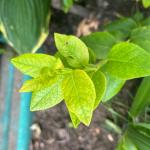
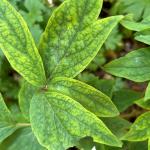
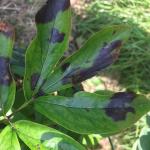 Peony leaf blotch was observed on some peonies. To manage peony leaf blotch, cut the stems at ground level in the fall and rake the area before new shoots appear.
Peony leaf blotch was observed on some peonies. To manage peony leaf blotch, cut the stems at ground level in the fall and rake the area before new shoots appear.
Leaf rollers were observed on summersweet clethra. Fungal leaf spots were also observed on witchhazel. Also observed was high pH iron deficiency on peony and blueberry. Iron deficiency can be corrected by applying acid fertilizers such as ammonium sulfate or applying elemental sulfur.
Multiflora rose (Rosa multiflora) continues to bloom and is easy to identify.
Weeds in the landscape continue to flourish. Take measures to control weeds before they set seed.
Mosquitoes and ticks are still very active. Protect yourself with insect repellent when working outdoors especially at dawn and at dusk.
East (Boston)
General Conditions:
The summer solstice, the astrological start of summer, occurred on June 20th at 4:51 PM. Our first heat wave of the season arrived on June 18th with a high of 94ºF, and is expected to last four days. The average daytime temperature, before the current heat wave arrived, was 79ºF, with overnight lows averaging 58ºF. We received 0.32 inches of precipitation over the past week. We gained 141 growing degree days, bringing us to 694 GDD’s (base 50).
There is an abundance of insect activity throughout the landscape. Lady bird beetle, both immatures and adults, are often seen together feeding on significant populations of aphids.
Pests/Problems:
We received 0.32 inches of precipitation over June 14th and 15th. Flagging of Hydrangea macrophylla (bigleaf hydrangea) and Petacites spp. (butterbur) is generally a reaction to the heat, not a lack of water.
Hibiscus sawfly larvae (Atomeracera decepta) are skeletonizing Hibiscus spp. (hardy hibiscus). The first instar, larval stage of dogwood sawfly (Macremphytus tarsatus) are active. These white, cottony masses can be seen developing on the underside of dogwood (Cornus spp.) leaves. The adult lilac borer moths (Podosesia syringae), that look more like wasps, are active seeking egg laying sites. Carpenter bees (Xylocopa spp.) are hovering around untreated wooden structures, protecting their nests. Columbine leafminer larvae (Phytomyza aquilegivora) are creating conspicuous serpentine tunnels in the foliage of hybrid columbine (Aquilegia x hybrida); the native columbine (Aquilegia canadensis) is not affected nearly as much. This is considered an aesthetic issue, as opposed to a threat to plant health.
Metro West (Acton)
General Conditions:
We welcome the summer season with this report and our first potential heat wave for 2024. Yesterday’s high temperature was recorded at 93º, and the forecast for the following two days is for a high of 94º and 97º. There’s nothing like starting the summer season with a heatwave! For June, the monthly average precipitation is 3.93” and 0.86” of rain has been recorded for this month so far. The landscape is lush and colorful with all that is in bloom and seen in some stage of bloom at this time are the following plants: Achillea millefoliumn (yarrow), Geranium ‘Johnson’s Blue’ (cranesbill), Hemerocallis 'Stella D'Oro' (daylily), Hemerocallis fulva (orange daylily), Lilium spp. (lily), Nepeta spp. (ornamental catmint), Oenothera macrocarpa (Ozark sundrops), and Stewartia psuedocamellia (Japanese stewartia).
Pests/Problems:
This hot weather that we are experiencing so early in the growing and planting season and combined with minimal rain will require supplemental watering to reduce any stress on plants. I have seen flagging foliage on newly planted trees, shrubs, and herbaceous plants.
Central Region (Boylston)
General Conditions:
During this reporting period in central Massachusetts, the weather has fluctuated, but the overall trend is toward hotter temperatures and drier soils. We are currently experiencing a record-breaking heat wave with temperatures of 91.9ºF and 92.9ºF on 6/18 and 6/19, respectively. Additionally, total precipitation has been low at 0.08”. On 6/15, storms brought rain and thunderclaps, but we have not seen nearly as much precipitation as last year in June. With summer upon us, we are looking forward to the sun it brings and, hopefully, some more rain.
Also of note, the plants around us are exploding with growth and many are blooming beautifully right now. The following are some of my highlights: bellflowers (Campanula spp.), woodland pinkroot (Spigelia marilandica), lanceleaf coreopsis (Coreopsis lanceolata), yarrow (Achillea spp.), and eastern prickly pear (Opuntia humifusa).
Pests/Problems:
Insect activity is also exploding with the growing season in full swing. The following species have been reported: dogwood sawflies (Macremphytus tarsatus), azalea leafminers (Caloptilia azaleella), spittlebugs (Philaenus spumarius) on everything, Eupatorium plume moth (Oidaematophorus eupatorii), and asparagus beetles (Crioceris asparagi) on our ornamental asparagus plants. We’ve also been experiencing a ton of leaf spot on our witchhazels (Hamamelis spp.) and some kind of white mildew on our common ninebark (Physocarpus spp.). Otherwise, many plants are feeling the heat stress from the last couple days and are prone to flagging.
Pioneer Valley (Amherst)
General Conditions:
The solstice has arrived, marking the official start of summer. This year, a searing heat wave was the final copilot on our annual journey to the longest day of the year. Blazing heat and thick humidity blanketed the Pioneer Valley with heat index values cresting well above 100ºF. With limited rainfall (at the time of writing), the landscape is starting to dry out across the Pioneer Valley. Soil moisture remains good at lower horizons, providing the necessary water for many established trees and shrubs with robust root systems. But for recent transplants and plants in sandy, well-drained soils, supplemental irrigation is necessary now.
As of June 11, only the town of Shelburne has any outdoor water use restrictions in place across the tri-counties. Automatic irrigation systems should be regularly checked to ensure they are operating properly and providing the intended amount of moisture. If hand-watering, check to ensure the root zone is properly wetted. Bark mulch can absorb a significant volume of water, leaving underlying soil dry.
The most recent rainfall on 6/14 failed to deliver significant precipitation for much of the valley. While parts of Hampden and eastern Hampshire counties recorded 2–3” from several scattered showers, the rest of the area was mostly shut out. Even still, the landscape remains green and lush as we round into the final third of June. New growth continues on plants with indeterminate growth rates, like crabapple, red maple. and eastern hemlock. But the honeymoon phase of the growing season is clearly over, and the rigors of the summer are starting to appear.
Pests/Problems:
Weeding and watering is now a primary garden task but also use this time to scout trees and shrubs at a close distance for symptoms of insect infestation and disease.
Both Oriental (Anomala orientalis) and Japanese (Popillia japonica) beetles are beginning to appear in Hampshire County. Powdery mildew fungi are visible on a variety of herbaceous and woody plants. Anthracnose diseases on maple, dogwood and cherry continue to be an issue. However, many of the fungal pathogens responsible for anthracnose have significantly reduced activity during hot and dry periods of mid-summer. Suspected Dutch elm disease flagging has been observed on wild elms and mid to late June is often a time when DED symptoms start to appear on infected trees.
An odd trend that has been reported and observed is the weak flowering on mature kousa dogwoods this year. While only affecting certain trees, several mature kousa dogwoods (Cornus kousa) have either only a limited number of flowers scattered throughout the canopy or isolated patches of dense flowers while the rest of the canopy has none. This weak bloom was not observed on flowering dogwoods (C. florida) earlier this spring.
Many spider mites thrive during extended periods of hot and dry weather. Lacebugs also thrive during dry periods on broadleaved evergreens such as rhododendrons, andromeda, and mountain laurel.
Berkshire Region (West Stockbridge)
General Conditions:
HOT is the term which best describes current conditions. Current temperatures are about 15 degrees above normal for this time of year. High temperatures for the scouting week of June 12 through 18 were all reached on the 18th with 91ºF at Richmond and North Adams, and 89ºF at Pittsfield Airport. Low temperatures for the period occurred on June 16 with 41ºF in Richmond, 44ºF in North Adams, and 45ºF in Pittsfield. Daily averages for the 3 sites were 67.3ºF in Richmond, 67.9ºF in Pittsfield, and 70.6ºF in North Adams.
Precipitation for the month thus far is below normal and the soil is quite dry. Spring planted materials will require watering, though the current forecast is calling for some showers over the weekend. Just the same, the amount of such rainfall requires watching and watering may be necessary, especially if the total for the weekend is less than an inch.
Growth of non-irrigated herbaceous plants has slowed somewhat, depending on the soil texture and amount of organic matter. Turfgrass growth has slowed a little but little to no browning of grass has been observed. Growth of one group of plants has not slowed, and that is the weeds.
Pests/Problems:
Hot humid weather has not slowed the activity of pests attracted to humans. These include mosquitoes, gnats, and deer ticks. Accounts of the latter attaching themselves to humans remain numerous.
Except for leaf spots, diseases are not all that common. However, black spot on roses, apple scab and cedar-apple rust on crabapples, leaf spot diseases such as that on box-elder (Acer negundo) are common sights.
As for plant pests, those observed during scouting this week were: wooly beech aphids on copper beech, spruce spider mites, magnolia leafminer on saucer magnolia (Magnolia x soulangeana), willow leaf beetle adults, and aphids on herbaceous and some woody plants. Damage to low growing herbaceous plants, such as hosta, by slugs was common despite the current dry period. Spittlebugs were observed on several trees, such as grey dogwood (Cornus racemose). However, spittlebugs do little to no harm to these hosts.
Regional Scouting Credits
- CAPE COD REGION - Russell Norton, Horticulture and Agriculture Educator with Cape Cod Cooperative Extension, reporting from Barnstable.
- SOUTHEAST REGION - Brian McMahon, Arborist, reporting from the Dighton area.
- NORTH SHORE REGION - Geoffrey Njue, Green Industry Specialist, UMass Extension, reporting from the Long Hill Reservation, Beverly.
- EAST REGION - Kit Ganshaw & Sue Pfeiffer, Horticulturists reporting from the Boston area.
- METRO WEST REGION – Julie Coop, Forester, Massachusetts Department of Conservation & Recreation, reporting from Acton.
- CENTRAL REGION - Mark Richardson, Director of Horticulture, and Anna Petrie, reporting from New England Botanic Garden at Tower Hill, Boylston.
- PIONEER VALLEY REGION - Nick Brazee, Plant Pathologist, UMass Extension Plant Diagnostic Lab, reporting from Amherst.
- BERKSHIRE REGION - Ron Kujawski, Horticultural Consultant, reporting from Great Barrington.
Woody Ornamentals
Diseases
Recent pests, pathogens, or problems of interest seen in the UMass Extension Plant Diagnostic Lab, a select few:
Black spot anthracnose of elm, caused by Stegophora ulmea (also known as Gnomonia ulmea). Two samples originated from mature Japanese elms (Ulmus davidiana var. japonica) growing in an arboretum. The trees reside on a northeast facing hillside with no mulch ring and occasional pruning. For the past several years, leaves become chlorotic in mid-May and are prematurely shed from the canopy. While the leaves were mostly free of disease, the petioles were blackened and badly diseased, leading to yellowing and premature shedding. On one of the trees, stem and branch cankering by Diplodia was also present. Both samples also had infestation of the European elm scale (Eriococcus spurius). A third sample originated from an elm (Ulmus sp.) growing in full sun at a residential landscape. Starting in early June, leaves began browning throughout portions of the canopy. The submitted branch segments illustrated a serious case of anthracnose with disease present on the foliage, petioles and succulent shoots. For the latter, black-colored lesions were scattered on the green shoots, which had yet to harden off. Black spot typically only occurs on the foliage, but infection of woody plant parts can occur on occasion.
Brown rot, caused by Monilinia fructicola, on Japanese flowering cherry (Punus ‘Kanzan’). The tree was transplanted into a residential landscape five years ago. It has a small mulch ring and receives some supplemental water from lawn irrigation. However, it was planted too deep and experiences only four hours of full sun. While exceptions occur, flowering cherries do not tolerate deep planting and develop chronic health issues. For the past few years, shoot tips have curled and leaves have turned brown in late May. The described symptoms are consistent with brown rot of cherry and the pathogen was abundant on the submitted sample. The slightly pigmented, lemon-shaped spore chains create a brown fuzzy mass on infected plant parts. The blighted shoot tips had infected flowers and undersized leaves at the terminal. Larger diameter stems were clean and free of disease. Brown rot is a common pathogen of Prunus, establishing within flowering parts and shoot tips in the spring on ornamental cherries. Inoculum can readily linger in dead shoots and perennial cankers, requiring thorough sanitation to control established outbreaks.
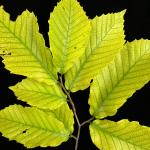 Iron (Fe) or Manganese (Mn) deficiency on American beech (Fagus grandifolia). The tree is 15-years-old and has been present at a nursery for three years. It resides in full sun with overhead irrigation in loam soils with good drainage. This spring, the foliage developed interveinal chlorosis while the veins remain green. This pattern is consistent with either Fe or Mn deficiency (and could be both). These two micronutrients are critical for growth and development. When soil pH is high in alkaline or calcareous soils, they become bound in insoluble forms and cannot be taken up. Applications of elemental sulfur, iron sulfate and iron chelates can lower soil pH and provide soluble forms of Fe, while manganese sulfate can provide the necessary Mn. However, an excess of micronutrients (especially Mn) can be toxic to plants, illustrating the sometimes delicate balance required for healthy growth and development.
Iron (Fe) or Manganese (Mn) deficiency on American beech (Fagus grandifolia). The tree is 15-years-old and has been present at a nursery for three years. It resides in full sun with overhead irrigation in loam soils with good drainage. This spring, the foliage developed interveinal chlorosis while the veins remain green. This pattern is consistent with either Fe or Mn deficiency (and could be both). These two micronutrients are critical for growth and development. When soil pH is high in alkaline or calcareous soils, they become bound in insoluble forms and cannot be taken up. Applications of elemental sulfur, iron sulfate and iron chelates can lower soil pH and provide soluble forms of Fe, while manganese sulfate can provide the necessary Mn. However, an excess of micronutrients (especially Mn) can be toxic to plants, illustrating the sometimes delicate balance required for healthy growth and development.
Report by Nick Brazee, Plant Pathologist, UMass Extension Plant Diagnostic Lab, UMass Amherst
Insects and Other Arthropods
The Professional Insect and Mite Management Guide for Woody Plants is freely available at https://ag.umass.edu/insectmiteguide. Please let me know how it is or isn’t working for you by responding to the following Feedback Form: Professional Insect & Mite Management Guide for Woody Plants. Your feedback is valuable and I cannot wait to hear from you!
Note: Our website is undergoing updates, and as such, the collapsible menus on the home page of the Guide are currently not functioning. Thank you for your patience as we await these updates.
Invasive Updates:
- Asian Longhorned Beetle is still present in Worcester, Shrewsbury, Boylston, West Boylston, and parts of Holden and Auburn, MA. If you suspect you’ve found this insect or the damage it causes, please report it to the Asian Longhorned Beetle Eradication Program office in Worcester, MA at 508-852-8090 or toll free at 1-866-702-9938.
To report an Asian longhorned beetle find online or to compare it to common insect look-alikes, visit: http://massnrc.org/pests/albreport.aspx
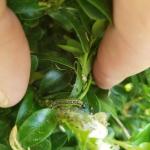
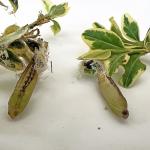
 Box Tree Moth has been detected in the following Massachusetts communities: Bourne, Sandwich, and Barnstable. A map of these locations is available at MDAR’s Invasive Pest Dashboard. If you believe you have found this insect, please take a photo, note your location, and report it immediately to the MA Department of Agricultural Resources using their Report a Pest Form. Box tree moth caterpillars were reported to be active at certain locations on Cape Cod, MA as of the week of April 19th. C.L. Fornari reports on 6/8/2024 that box tree moth pupae are present at a location in Sandwich, MA at this time (see photos). These pupae are likely the overwintered caterpillars that were actively feeding in April which will give rise to the next generation of adults.
Box Tree Moth has been detected in the following Massachusetts communities: Bourne, Sandwich, and Barnstable. A map of these locations is available at MDAR’s Invasive Pest Dashboard. If you believe you have found this insect, please take a photo, note your location, and report it immediately to the MA Department of Agricultural Resources using their Report a Pest Form. Box tree moth caterpillars were reported to be active at certain locations on Cape Cod, MA as of the week of April 19th. C.L. Fornari reports on 6/8/2024 that box tree moth pupae are present at a location in Sandwich, MA at this time (see photos). These pupae are likely the overwintered caterpillars that were actively feeding in April which will give rise to the next generation of adults.
The USDA APHIS has announced a new quarantine for box tree moth in Massachusetts and Ohio, and has expanded existing quarantines in Michigan and New York. This includes conditions for interstate movement of regulated Buxus species. This quarantine includes the entire Commonwealth of Massachusetts. The federal order states:
“Boxwood plants may only be moved interstate from a quarantined area from an establishment operating under a compliance agreement, and only if accompanied by a certificate issued by a State Agricultural Authority certifying that the requirements of this Federal Order and the compliance agreement have been met. These requirements will prevent producers and distributors of boxwood from moving infested plants interstate. State Agricultural Authorities may prescribe additional safeguards and protocols.
All other regulated articles of boxwood, including plant parts, pieces, cuttings, clippings, debris, and any portion of the plant, alive or dead, except for decorative purposes, are prohibited from movement.”
MDAR has recently sent a notice to boxwood growers in Massachusetts of the following:
"Effective May 22, 2024, the USDA has issued a Federal Order establishing a quarantine for the entire state of Massachusetts. In an effort to restrict the movement of box tree moth, boxwoods (Buxus spp.) may no longer be exported from Massachusetts except by an establishment operating under a compliance agreement (CA) to be issued by MDAR. Anyone wishing to register for a CA must go to the Massachusetts Department of Agricultural Resources box tree moth page and click on the EXPORTS link, and fill out the form. An MDAR staff person will follow up within one week. Please note that the quarantine does NOT restrict in-state sales, movement within the state, or import of boxwoods into Massachusetts. If you have any further questions, please feel free to contact either MDAR (taryn.lascola@mass.gov) or USDA (203-741-5641)."
To read the full announcement of the box tree moth quarantine for Massachusetts from MDAR, please visit the Massachusetts Introduced Pests Outreach Blog.
Need information about monitoring and trapping box tree moth? Check out this newly available Box Tree Moth Monitoring & Trapping fact sheet from UMass Extension.
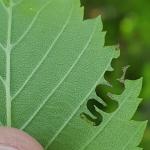
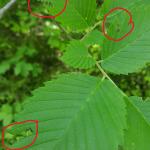 Elm Zigzag Sawfly has been detected in the following Massachusetts communities: Becket, Chester, Windsor, and Williamstown. If you believe you have found this insect, please take a photo, note your location, and report it immediately using MA DCR’s Massachusetts Elm Zigzag Sawfly Reporting Form. Felicia Hubacz, MA DCR, reports elm zigzag sawfly larvae actively feeding in the Becket, MA population as of 5/28/2024. UMass Extension observed tiny elm zigzag sawfly feeding in the Windsor, MA population on 5/31/2024 (see photos).
Elm Zigzag Sawfly has been detected in the following Massachusetts communities: Becket, Chester, Windsor, and Williamstown. If you believe you have found this insect, please take a photo, note your location, and report it immediately using MA DCR’s Massachusetts Elm Zigzag Sawfly Reporting Form. Felicia Hubacz, MA DCR, reports elm zigzag sawfly larvae actively feeding in the Becket, MA population as of 5/28/2024. UMass Extension observed tiny elm zigzag sawfly feeding in the Windsor, MA population on 5/31/2024 (see photos).
Now is the time to search for elm zigzag sawfly larvae actively feeding on their host plants! Please report any suspicious defoliation of elm to the previous reporting link.
- Emerald Ash Borer is well established across most of Massachusetts. A map of these locations from the MA Department of Conservation and Recreation is available.
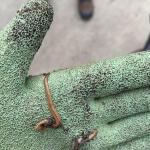
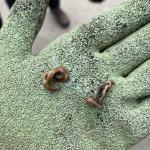 Hammerhead Worms: Also known as flatworms or land planarians, belong to Phylum Platyhelminthes (flat worms) rather than Arthropoda (arthropods) which makes them different from insects and their relatives. Class Insecta is the taxonomic classification of the Insects, whereas hammerhead worms belong to Class Turbellaria. A few common species of non-native hammerhead worms noted in New England include but are not limited to: Bipalium kewense, Bipalium adventitium, and Bipalium pensylvanicum. For more information, see this article in Hort Notes on Hammerhead Worms in New England.
Hammerhead Worms: Also known as flatworms or land planarians, belong to Phylum Platyhelminthes (flat worms) rather than Arthropoda (arthropods) which makes them different from insects and their relatives. Class Insecta is the taxonomic classification of the Insects, whereas hammerhead worms belong to Class Turbellaria. A few common species of non-native hammerhead worms noted in New England include but are not limited to: Bipalium kewense, Bipalium adventitium, and Bipalium pensylvanicum. For more information, see this article in Hort Notes on Hammerhead Worms in New England.
Sightings of these organisms have increased in recent years, possibly due to warming winters and wet summers. Hammerhead worms are predators that prefer to feed on earthworms; however, depending upon the species involved, they may not be an effective predator of certain species of jumping worms. Again in 2024, reports of hammerhead worms have come from parts of Massachusetts (in this case, Martha’s Vineyard; see photos) with questions about safety. Hammerhead worms are known to produce a neurotoxin (tetrodotoxin) which they use in self-defense and to subdue prey. Luckily, hammerhead worms do not produce enough tetrodotoxin to be lethal to humans, but if the neurotoxin comes into contact with exposed skin, irritation may occur. It is advised that handling hammerhead worms should be avoided, and hands or exposed skin be washed with soap and water following any accidental contact.- Jumping Worms are non-native earthworms that impact natural ecosystems. Available resources include a fact sheet about earthworms in Massachusetts and jumping worm FAQ’s.
- Spotted Lanternfly now has established populations in the following locations in Massachusetts: Holyoke, Springfield, West Springfield, Agawam, Fitchburg, Worcester, Shrewsbury, Southborough, Ashland, Wellesley, Weston, Chelmsford and the newest confirmed population in Grafton. The MA Department of Agricultural Resources reported that spotted lanternfly egg hatch had begun in Holyoke and Springfield, MA as of 5/14/2024.
At this point in the growing season, the life stage of spotted lanternfly that is active are the nymphs (immatures). Spotted lanternfly nymphs are black with white spots (instars 1-3) and change their color to include red patches (instar 4) with the black base with white spots just before maturing into adults. Fourth instar nymphs may not be present until sometime in July.
UMass Extension has received reports of suspicious insects that were thought to be adult spotted lanternflies. Adult SLF may not be present in established populations in MA until late July. Right now, we suspect that the suspicious insects that were seen were adult SLF lookalikes, such as some of the tiger moths or underwing moths. The MA Department of Agricultural Resources provides a great spotted lanternfly look-alike sheet for the nymph and adult life stages.
If you believe you have found this insect, please take a photo, note your location, and report it immediately using the Spotted Lanternfly Report Form. Available resources include a map of spotted lanternfly locations in Massachusetts from the MA Department of Agricultural Resources, MDAR’s spotted lanternfly fact sheet, UMass Extension’s Spotted Lanternfly Management Guide, and an SLF InsectXaminer episode.
Medically Important Pests:
- Ticks are a serious public health concern and may be active in managed landscapes any time temperatures are above freezing. Encounters with deer ticks can increase in New England in April, October, and November; however, precautions should be taken year-round to prevent tick bite exposure. Available resources include tick information from Cape Cod Cooperative Extension, personal protective measures, and a list of potential tick testing resources. The New England Center of Excellence in Vector-Borne Diseases (NEWVEC) also provides the latest tick information and resources.
- Mosquitoes and the diseases they vector are also a serious public health concern in Massachusetts by summer. Available resources include Mosquito Repellents from the Department of Public Health and Prevent Mosquito Bites from the Centers for Disease Control and Prevention. The Massachusetts Department of Public Health tests for Eastern Equine Encephalitis (EEE) and West Nile Virus (WNV) from June to October. Beginning June 17th, Massachusetts risk maps will be available for both EEE and WNV.
- Wasps/Hornets: Many wasps are predators of other arthropods, including pest insects such as certain caterpillars that feed on trees and shrubs. Adult wasps hunt prey and bring it back to their nest where young are being reared as food for the immature wasps. A common such example are the paper wasps (Polistes spp.) who rear their young on chewed up insects. Paper wasps can sting, and will defend their nests, which are open-celled paper nests that are not covered with a papery “envelope”. These open-celled nests may be seen hanging from eaves or other outdoor building structures. Aerial yellow jackets and hornets create large aerial nests that are covered with a papery shell or “envelope”. Common yellow jacket species include those in the genus Vespula. Dolichovespula maculata is commonly known as the baldfaced hornet, although it is not a true hornet. The European hornet (Vespa crabro) is three times the size of a yellow jacket and may be confused for the northern giant hornet (Vespa mandarinia). The European hornet is known to Massachusetts, but the northern giant hornet is not. If you are concerned that you have found or photographed a northern giant hornet, please report it using the MA Department of Agricultural Resources Report Pest Sightings page. Some people are allergic to stinging insects, so care should be taken around wasp/hornet nests. Unlike the European honeybee (Apis mellifera), wasps and hornets do not have barbed stingers and therefore can sting repeatedly when defending their nests. It is best to avoid them and, if that cannot be done and assistance is needed to remove them, consult a professional.
Tree & Shrub Insect & Mite Pest Suggested Scouting:
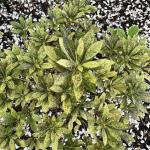 Andromeda Lace Bug is most commonly encountered on Japanese andromeda, however other host plants may be impacted. Most activity from this insect occurs between late May through September, with several generations occurring per year. Both nymphs and adults feed on host plant leaf undersides and cause white/yellow-colored spots or chlorosis to occur on host plant leaf surfaces. This image from 5/9/2024 (Boston, MA) shows Pieris japonica ‘Cavatine’ with old andromeda lace bug feeding damage from 2023 and possible winter injury. Samples were submitted to the UMass Extension Plant Diagnostic Lab. As of now, the new growth is starting to show damage as well, after developing without it. Boston, MA was at 132 GDD’s on 5/12/2024 and andromeda lace bug is known to begin activity by 120 GDD’s. (Image courtesy of Susan Shafer.)
Andromeda Lace Bug is most commonly encountered on Japanese andromeda, however other host plants may be impacted. Most activity from this insect occurs between late May through September, with several generations occurring per year. Both nymphs and adults feed on host plant leaf undersides and cause white/yellow-colored spots or chlorosis to occur on host plant leaf surfaces. This image from 5/9/2024 (Boston, MA) shows Pieris japonica ‘Cavatine’ with old andromeda lace bug feeding damage from 2023 and possible winter injury. Samples were submitted to the UMass Extension Plant Diagnostic Lab. As of now, the new growth is starting to show damage as well, after developing without it. Boston, MA was at 132 GDD’s on 5/12/2024 and andromeda lace bug is known to begin activity by 120 GDD’s. (Image courtesy of Susan Shafer.)- Arborvitae Leafminer moths appear from mid-June to mid-July and lay their eggs. Eggs hatch and larvae enter the leaves where they feed, often unnoticed until January or February when browned leaf tips become more apparent. Feeding from this insect is sometimes confused for winter injury, and vice versa.
- Azalea Lace Bug is a pest of both deciduous and evergreen azaleas (Rhododendron spp.), however resistance has been reported in Rhododendron atlanticum, R. arborescens, R. canescens, R. periclymenoides, and R. prunifolium. The insects feed on host plant leaf undersides, and cause chlorosis on leaf surfaces. Azalea lace bugs are active from 120+ GDD’s throughout the summer.
- Azalea Sawflies is a common name that might refer to three different species of sawflies that feed on azaleas. Adults of Amauronematus azaleae are often present in May and laying eggs which hatch into larvae that typically mature by July 1st. At that time, they finish feeding and drop to the soil to pupate. These green larvae feed on the edges of host plant leaves and may defoliate the plant.
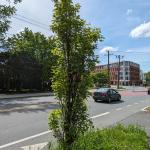
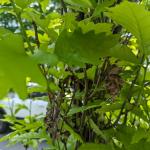

Bagworm caterpillar feeding is underway! Early instar caterpillars (below 2/3 inch in length) are very susceptible to Btk (Bacillus thuringiensis Kurstaki). Apply to actively feeding, young caterpillars once all eggs have hatched, but before caterpillars exceed 2/3 inch in length. For great photos of early-instar bagworms, visit The Ohio State University Extension's Buckeye Yard & Garden onLine (BYGL).

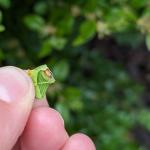 Boxwood Leafminer adult emergence occurs by mid-May, with pupal cases left behind clinging to leaves. Boxwood leafminer pupae were found in boxwood leaves in Berkshire County (Dalton, MA) on 5/11/2024. Shake bushes to detect flying adults. Resistant varieties of boxwood are available; see preceding link.
Boxwood Leafminer adult emergence occurs by mid-May, with pupal cases left behind clinging to leaves. Boxwood leafminer pupae were found in boxwood leaves in Berkshire County (Dalton, MA) on 5/11/2024. Shake bushes to detect flying adults. Resistant varieties of boxwood are available; see preceding link.- Bronze Birch Borer adults emerge from susceptible host plants in early mid-June. Mating and egg laying will occur, and eggs will be laid singly or in groups on host plant bark. Eggs hatch and larvae bore beneath the bark to feed. European white birch (Betula pendula) and Himalayan birch (Betula jacquemontii) are preferred host plants.
- Cankerworms can be found feeding on similar host plants in the spring, despite fall and spring cankerworm being different species of insects. Spring cankerworm adult moths are active in February and March, laying masses of 100 or so eggs in the rough bark of larger branches or the trunk of the host plant. Fall cankerworm adults laid their masses of eggs on host plant branches and twigs, back in late November and early December of last year (sometimes the current year’s January). Egg hatch of both species will occur by approximately mid-May, with caterpillar feeding through roughly the end of June.
- Cottony Camelia Scale/Cottony Taxus Scale crawlers are typically active between 802 to 1388 GDD's and can be targeted for management on infested host plants. Monitor preferred hosts such as camellia, euonymus, holly, Japanese maple, pittosporum, and yew. Plants may seem off color, with light green foliage. Honeydew and sooty mold may also be present.
- Cottony Maple Scales are two species of soft scale that are present on a variety of host plants, including but not limited to maple, apple, dogwood, and many others. Crawlers may be active between 802-1265 GDD's. Crawlers may be present on the undersides of host plant leaves. Management may not be necessary unless the population on an individual plant is high.
- Cryptomeria Scale first generation crawlers are present from approximately 600-800 GDD's and second generation crawlers are present from 1750-2130 GDD's. Look for discolored needles on susceptible host plants. Check the undersides of needles for the hardened scale covers and/or yellow crawlers. Crawlers present in June and August. Scout for scale insects on the underside of needles on the inside of bottom branches first. Scouting on overcast days may make it easier to see the symptoms caused by cryptomeria scale infestation. Yellow sticky cards can be placed in infested trees to aid in scouting for adult (winged) male emergence. Egg laying will begin soon after males are seen. Check scale covers for round exit holes left behind by natural enemies.
- Dogwood Borer is a species of clearwing moth whose larvae bore not only into dogwood (Cornus), but hosts also include flowering cherry, chestnut, apple, mountain ash, hickory, pecan, willow, birch, bayberry, oak, hazel, myrtle, and others. Kousa dogwood appears to be resistant to this species. Signs include the sloughing of loose bark, brown frass, particularly near bark cracks and wounds, dead branches, and adventitious growth. The timing of adult emergence can be expected when dogwood flower petals are dropping and weigela begins to bloom. Adult moth flights continue from then until September.
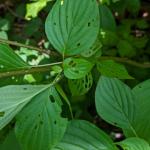
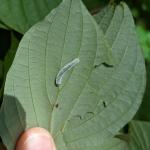 Dogwood Sawfly eggs have hatched and young sawflies are munching their way through dogwood leaves. See photos taken on 5/28/2024 in Chesterfield, MA. Dogwood sawflies are not susceptible to Btk (Bacillus thuringiensis Kurstaki) however, spinosad should be effective on young dogwood sawfly larvae.
Dogwood Sawfly eggs have hatched and young sawflies are munching their way through dogwood leaves. See photos taken on 5/28/2024 in Chesterfield, MA. Dogwood sawflies are not susceptible to Btk (Bacillus thuringiensis Kurstaki) however, spinosad should be effective on young dogwood sawfly larvae.- Euonymus Scale overwinters as a fertilized female. Eggs are laid beneath dark brown female scale covers in the early spring. Egg hatch occurs over a 2-3 week period, with crawlers present by early June. While Euonymus spp. host plants are preferred, additional host plants have been reported.
- Fall Webworm eggs may hatch by late June or early July, depending on local conditions. Young larvae begin feeding in groups, and eventually cover entire branches with webbing as they mature. This native insect can typically coexist with its host plants. If webs cannot be tolerated on ornamental trees or shrubs, monitor for them on the tips of branches when they are still small, and prune out and remove.
- Hemlock Looper collectively refers to two species of geometrid (inchworm; looper) caterpillars. Overwintered eggs hatch by late May or early June, at which time young larvae begin their messy feeding on host plant needles. Hemlock and balsam fir are preferred hosts. Hemlock looper caterpillars mature slowly, and may not begin pupation until late July with adults emerging by September and October.
- Imported Willow Leaf Beetle adults overwinter in loose bark or other sheltered areas near susceptible Salix and Populus spp. host plants. Once the host plant leaves emerge in the spring, adults will begin to feed and lay tiny, yellow eggs in clusters on leaf undersides. Additional resources include an InsectXaminer episode about imported willow leaf beetle.
- Juniper Scale egg laying and crawler emergence may be complete by the end of June. Yellowed foliage and premature needle drop may occur. Heavy infestations (10 or more scales per 1/2 inch of branch) can kill host plants.
- Mimosa Webworm caterpillars should be monitored on susceptible hosts for activity and webbing beginning in the end of June, early July. The larvae (caterpillars) of this insect tie the foliage of their hosts together with silken strands and skeletonize the leaves. Injury to host plant leaves may be noticeable by early July in Massachusetts. Foliage can appear bronzed in color from the feeding. Webbing usually begins at the tops of trees. An entire tree may become covered in the webs created by these caterpillars.
- Pitch Mass Borer overwinters in the pitch mass found on the host plant. This insect tunnels beneath the bark, into the cambium. It may take up to two years for the pitch mass borer to mature. Pupation typically occurs by the end of May through June, in time for adult clearwing moth emergence in July and August.
- Privet Thrips are a non-native insect pest of privet, lilac, and ash. Thrips feed on the leaves of privet, causing them to appear gray in color made up of chlorotic spots. Immature thrips may be viewed with magnification on the undersides of host plant leaves. Several generations per year may be possible throughout the summer.
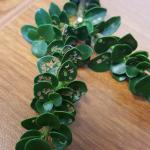
 Redheaded Flea Beetle (Systena frontalis) has been identified as a native pest of nurseries in many locations in the eastern United States. Suspected redheaded flea beetle damage was seen on Ilex crenata 'Dwarf Pagoda' (Dwarf Pagoda Japanese holly) on 3/27/2024 that was purchased in Massachusetts but may have originated in NJ. While identification of this species of insect is uncertain based on host plant damage alone, it appears to be a reasonable and educated assumption. Redheaded flea beetles are known to feed on a wide variety of host plants. These include but are not limited to: cabbage, beans, beets, blueberries, and other agricultural crops as well as Physocarpus, Weigelia, Cornus, Forsythia, Itea, Hydrangea, and Ilex. Adult beetles are active and feed from approximately late-June to mid-September on the upper and lower leaf surfaces of their hosts. This can cause damage that looks like skeletonization and eventually holes in the leaves. Leaves appear covered in brown patches as in these photos. This damage was caused last season on this evergreen plant.
Redheaded Flea Beetle (Systena frontalis) has been identified as a native pest of nurseries in many locations in the eastern United States. Suspected redheaded flea beetle damage was seen on Ilex crenata 'Dwarf Pagoda' (Dwarf Pagoda Japanese holly) on 3/27/2024 that was purchased in Massachusetts but may have originated in NJ. While identification of this species of insect is uncertain based on host plant damage alone, it appears to be a reasonable and educated assumption. Redheaded flea beetles are known to feed on a wide variety of host plants. These include but are not limited to: cabbage, beans, beets, blueberries, and other agricultural crops as well as Physocarpus, Weigelia, Cornus, Forsythia, Itea, Hydrangea, and Ilex. Adult beetles are active and feed from approximately late-June to mid-September on the upper and lower leaf surfaces of their hosts. This can cause damage that looks like skeletonization and eventually holes in the leaves. Leaves appear covered in brown patches as in these photos. This damage was caused last season on this evergreen plant.- Rhododendron Borer is one of the smallest of the native clearwing moths. Adult emergence may begin in May and can last through July, depending upon local temperatures. Rhododendron are preferred host plants, with the larvae of this species boring into stems, often near the base of plants. Injured plant parts may be more attractive to these insects.

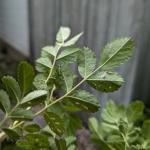 Roseslugs is a common name for at least two species of sawflies whose larvae may be found feeding on the foliage of roses. These small larvae will skeletonize the upper leaf surface and leave a “windowpane”-like pattern behind. If present in large numbers, entire shrubs can be defoliated. Monitor for feeding larvae from the end of May through June. Roseslugs are still feeding as of 5/17/2024 in Williamsburg, MA as pictured here.
Roseslugs is a common name for at least two species of sawflies whose larvae may be found feeding on the foliage of roses. These small larvae will skeletonize the upper leaf surface and leave a “windowpane”-like pattern behind. If present in large numbers, entire shrubs can be defoliated. Monitor for feeding larvae from the end of May through June. Roseslugs are still feeding as of 5/17/2024 in Williamsburg, MA as pictured here.- Southern Pine Beetle has been trapped in Massachusetts since 2015. By 2022 and 2023, southern pine beetle has reached outbreak conditions in small areas of the state, killing pitch pine (Pinus rigida). (Particularly on Martha’s Vineyard and Nantucket islands in MA.) If you believe you have found infested pitch pine in Massachusetts, please report southern pine beetle using the Massachusetts Southern Pine Beetle Reporting Form from MA DCR.
- Spruce Bud Scale overwinters as an immature scale on the undersides of host plant needles. Once spring temperatures warm, the dormant scales become active by late March and in April female spruce bud scales move to host plant twigs. Adult females are reddish-brown and round, and usually found at the base of new twig growth. In this location, they finish maturing and eggs are retained in the female spruce bud scale body cavity where, eventually, crawlers develop. These immature and mobile crawlers appear by approximately the beginning of June and may remain active through July. They then find suitable locations to settle and begin their feeding on the new growth of the plant. During this time, copious amounts of honeydew (sugary liquid excrement) may be excreted.
- Tuliptree Scale is a soft scale pest of Liriodendron and Magnolia spp. among others. Second instar nymphs overwinter, begin feeding as temperatures warm in the spring, and mature into adults by the late spring/early summer.
- Twospotted Spider Mite season is under way as warm temperatures rise! Populations on many different deciduous and some coniferous hosts may rise from 363-618 GDD's and again from 1300-2000 GDD's. Twospotted spider mites prefer hot, dry conditions in the summer and fall. Population increases and subsequent plant damage can occur under these conditions. Using piercing-sucking mouthparts, mites feed primarily on the underside of host plant leaves and remove fluids. This feeding causes graying or yellowing of the leaves. Necrotic spots can also occur in advanced stages of leaf damage. This may lead to a stippled/bleached appearance of leaves; on occasion, complete defoliation due to spider mite activity is possible under high populations. Twospotted spider mites also create a fine webbing which can be found on infested plants.
Magnification is needed to visually detect twospotted spider mites. At least a 10-15X hand lens is required. The undersides of host plant leaves can be examined for the mites themselves or their shed or cast skins, as well as the fine webbing left behind by spider mites. However, it may be easier to view twospotted spider mites when a branch that is suspected to be infested is shaken or struck over a white piece of paper. See previous link for more details.
- Viburnum Leaf Beetle larvae may be found anywhere on the leaves and usually in groups. When young, larvae feed on the undersides of the leaves. As they grow larger, they may feed on the upper surface. Larval development may take approximately 8-10 weeks to complete and 3 larval instars are reported. Pupae are yellowish and are found in the soil beneath the host plant. Adults emerge around the middle of July and are brown, smaller than the largest larvae (approximately ¼ inch), and will also feed on the leaves. Adults are present in the landscape until the first hard frost.
- White Pine Aphid is a large, black, long-legged aphid found on twigs and small branches of eastern white pine. Search for aphids beginning in May and June. As the season progresses, honeydew and sooty mold may coat branches and needles of the host plant.
- White Spotted Pine Sawyer is a native longhorned beetle that is often confused for the invasive Asian longhorned beetle (see entry above). White spotted pine sawyer adults emerge in late May throughout July in MA. This insect completes its life cycle in weakened or recently dead conifers, particularly eastern white pine (Pinus strobus). It is not a significant pest. However, if you are unsure of the identification of a longhorned beetle, always take a photo and report it. You can report suspicious insects at the MA Department of Agricultural Resources Introduced Species Outreach Project Report a Pest Form.
- Yellow Poplar Weevil is also known as the sassafrass weevil, the magnolia leafminer, or the tulip tree leafminer. This insect, as all of these common names suggest, feeds on yellow poplar (tulip tree; Liriodendron tulipifera), sassafras (Sassafras albidum), magnolia (Magnolia spp.), as well as bay laurel (Laurus nobilis). Adult beetles lay eggs in the midribs of host plant leaves by May, after which the eggs hatch and larvae feed by creating blotch mines in the leaves. Larvae can be observed in May and June, and adults emerging to feed again by August, prior to overwintering in sheltered areas.
Beneficials/Non-Pests:
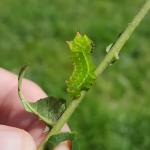
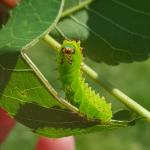 Luna Moth caterpillars are spectacular to behold! Walnut, hickory, and birch may be preferred host plants, but preferences in the luna moth population vary depending upon location. These caterpillars will mature into one of North America's most beautiful moths and are found from parts of Canada all the way south to Florida. These luscious caterpillars should be preserved and encouraged.
Luna Moth caterpillars are spectacular to behold! Walnut, hickory, and birch may be preferred host plants, but preferences in the luna moth population vary depending upon location. These caterpillars will mature into one of North America's most beautiful moths and are found from parts of Canada all the way south to Florida. These luscious caterpillars should be preserved and encouraged.
Report by Tawny Simisky, Extension Entomologist, UMass Extension Landscape, Nursery & Urban Forestry Program
Landscape Weeds
For information about identification of weeds noted below, check out UMass Extension's Weed Herbarium.
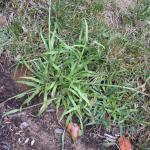 Thin or bull paspalum, Paspalum setaceum, is beginning to rear its ugly head in turf: A large crabgrass lookalike, this grassy weed is a warm-season perennial. Standard cultural practices and herbicides that manage crabgrass will not manage paspalum. Paspalum setaceum is often misidentified as dallisgrass, Paspalum dilatatum, a weedy perennial grass of southern turf. Applications of PylexTM are the best choice. Apply Pylex only if the turfgrass is not under moisture and/or heat stress. Use sequential applications if the paspalum should rebound. Applications of PylexTM can begin now and continue through the month of August. The active ingredient in PylexTM is topramezone. Its mode of action is an HPPD inhibitor and, like mesotrione, will cause the bleaching of cool season turfgrasses. The addition of triclopyr will reduce bleaching symptoms. Consider physical removal where populations are small. Widespread populations may require a reseeding renovation after an application of a translocated non-selective herbicide such as glyphosate.
Thin or bull paspalum, Paspalum setaceum, is beginning to rear its ugly head in turf: A large crabgrass lookalike, this grassy weed is a warm-season perennial. Standard cultural practices and herbicides that manage crabgrass will not manage paspalum. Paspalum setaceum is often misidentified as dallisgrass, Paspalum dilatatum, a weedy perennial grass of southern turf. Applications of PylexTM are the best choice. Apply Pylex only if the turfgrass is not under moisture and/or heat stress. Use sequential applications if the paspalum should rebound. Applications of PylexTM can begin now and continue through the month of August. The active ingredient in PylexTM is topramezone. Its mode of action is an HPPD inhibitor and, like mesotrione, will cause the bleaching of cool season turfgrasses. The addition of triclopyr will reduce bleaching symptoms. Consider physical removal where populations are small. Widespread populations may require a reseeding renovation after an application of a translocated non-selective herbicide such as glyphosate.
Crabgrass (and other annual grassy weed) management in turf: Recent rainfall and very warm weather is moving crabgrass along and you need to bring your “A Game.” Routinely monitor all turf areas regardless of whether they received a preemergence herbicide application or not. Postemergence herbicides will effectively manage crabgrass. Determination of the predominant growth stage will dictate the herbicide selection (see table below).
Postemergence herbicides for crabgrass control |
||||||
|---|---|---|---|---|---|---|
|
Postemergence Herbicide |
Crabgrass Growth Stage LF = leaf, TL = tiller |
|||||
|
1- to 5-LF |
1-TL |
2-TL |
3-TL |
4-TL |
5-TL & up |
|
|
dithiopyr |
YES |
YES |
YES |
YES |
NO |
NO |
|
mesotrione |
YES |
YES |
YES |
YES |
NO |
NO |
|
quinclorac |
YES |
YES |
NO |
NO |
NO |
YES |
|
fenoxaprop |
YES |
YES |
NO |
NO |
NO |
NO |
Scout for annual weeds in ornamental beds: Recent rainfall and warm weather has pushed summer annual weed germination and establishment along. Evaluate the efficacy of spring applied preemergence herbicides. Treat these weeds before they get too large. Spot spraying with a non-selective herbicide (glyphosate or glufosinate) is usually a better strategy than hand-weeding as it does not break the mulch barrier.
Japanese knotweed (Fallopia japonica): Do not attempt to control Japanese knotweed, as herbicide applications are not effective in the early part of the growing season. In preparation for a late season herbicide application, cut or mow stands of knotweed to the ground in late May and early June. This practice will facilitate herbicide application by removing the dried stems from the previous year’s growth and will control plant height to make herbicide treatment easier in late summer. Removal of new top grow can reduce the plant’s carbohydrate reserves with this early season mowing.
Ground ivy (Glechoma hederacea) in turf and landscapes: This often “tough-to-manage” weed is currently just past its flowering period. Management of ground ivy is usually not effective during the early part of the growing season. Application of triclopyr in September and October is the best option. Treat ground ivy in landscape beds with a direct-spray application of glyphosate or glufosinate.
Garlic mustard (Alliaria petiolata): A biennial weed considered invasive in Massachusetts and other Northeast states. Second year plants have completed their flowering period and seedpods are still green. Green seedpods contain seeds that are not yet mature and lack reproductive ability. An herbicide application now will control the second-year plants before they produce viable seed as well as the first year seedling plants that have germinated below the canopy of the second-year plants.
Report by Randy Prostak, Weed Specialist, UMass Extension Landscape, Nursery, and Urban Forestry Program
Additional Resources
Pesticide License Exams by the MA Dept. of Agricultural Resources (MDAR) are now held online. For more information and how to register, go to: https://www.mass.gov/pesticide-examination-and-licensing.
To receive immediate notification when the next Landscape Message update is posted, join our e-mail list or follow us on Facebook.
For a complete listing of landscape, nursery, and urban forestry program upcoming events, see our calendar at https://ag.umass.edu/landscape/upcoming-events.
For commercial growers of greenhouse crops and flowers - Check out UMass Extension's Greenhouse Update website.
For professional turf managers - Check out our Turf Management Updates.
For home gardeners and garden retailers - Check out our home lawn and garden resources.
Diagnostic Services
UMass Laboratory Diagnoses Landscape and Turf Problems - The UMass Extension Plant Diagnostic Lab is available to serve commercial landscape contractors, turf managers, arborists, nurseries and other green industry professionals. It provides woody plant and turf disease analysis, woody plant and turf insect identification, turfgrass identification, weed identification, and offers a report of pest management strategies that are research based, economically sound and environmentally appropriate for the situation. Accurate diagnosis for a turf or landscape problem can often eliminate or reduce the need for pesticide use. For sampling procedures, detailed submission instructions and a list of fees, see the Plant Diagnostic Laboratory web site.
Soil and Plant Nutrient Testing - The University of Massachusetts Soil and Plant Nutrient Testing Laboratory is located on the campus of the University of Massachusetts at Amherst. Testing services are available to all. The lab provides test results and recommendations that lead to the wise and economical use of soils and soil amendments. For more information, including current turn-around times, visit the UMass Soil and Plant Nutrient Testing Laboratory web site. The lab is currently accepting orders for Routine Soil Analysis (including optional Organic Matter, Soluble Salts, and Nitrate testing), Particle Size Analysis, Pre-Sidedress Nitrate (PSNT), Total Sorbed Metals, and Soilless Media (no other types of soil analyses available at this time). Check for current turnaround time. Please plan for the fact that date of receipt in the lab is affected by weekends, holidays, shipping time, and time for UMass Campus Mail to deliver samples to the lab.
Tick Testing - The UMass Center for Agriculture, Food, and the Environment provides a list of potential tick identification and testing options at https://ag.umass.edu/resources/tick-testing-resources.
Acknowledgements: UMass Extension gratefully acknowledges the support of the following funding sources for the production of the Landscape Message –
- The Massachusetts Nursery and Landscape Association Fund
- The Massachusetts Department of Conservation and Recreation, Award #ISADCR28219926UMA24A
- Stakeholders like you! The Landscape Message is partially supported by educational program user fees.